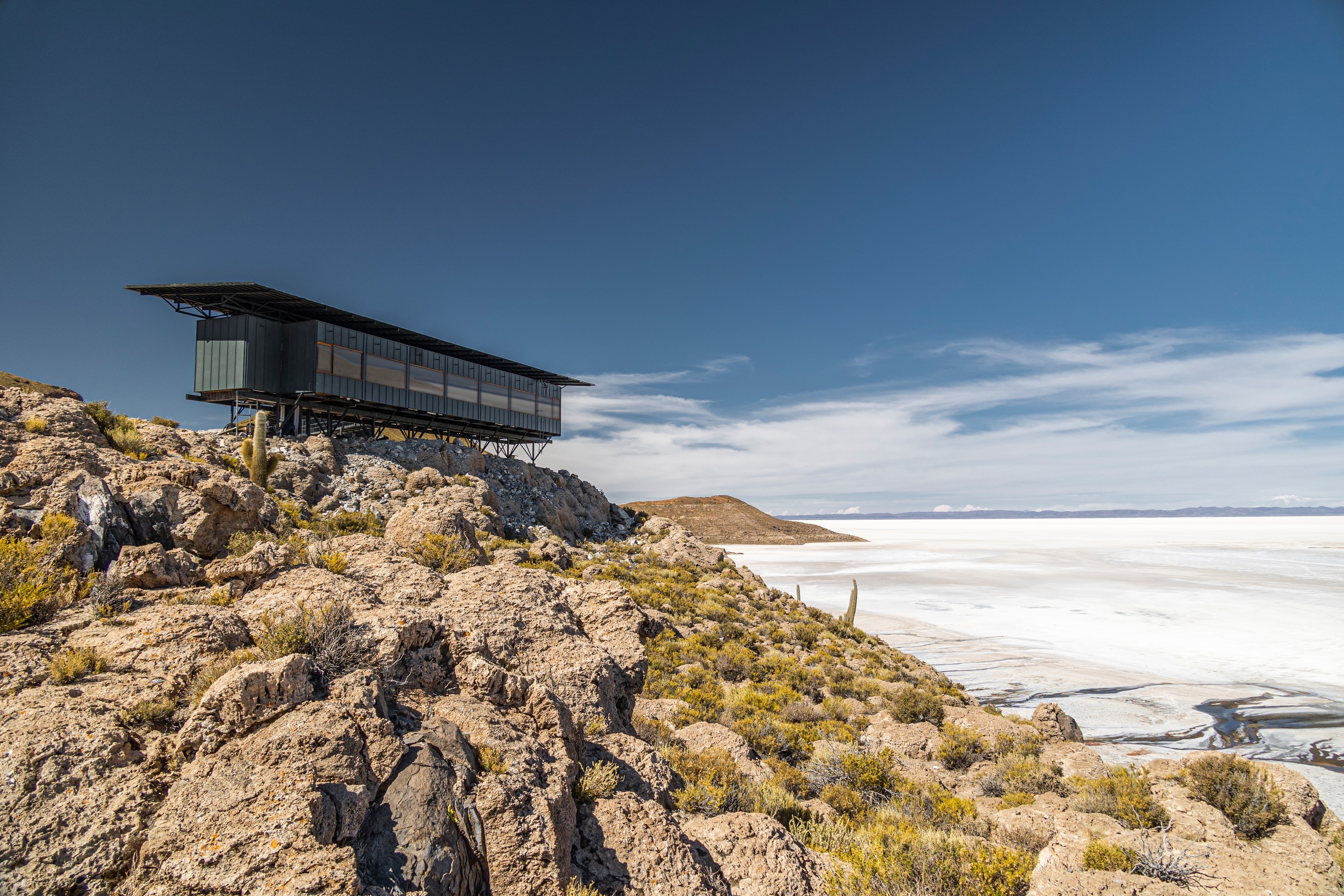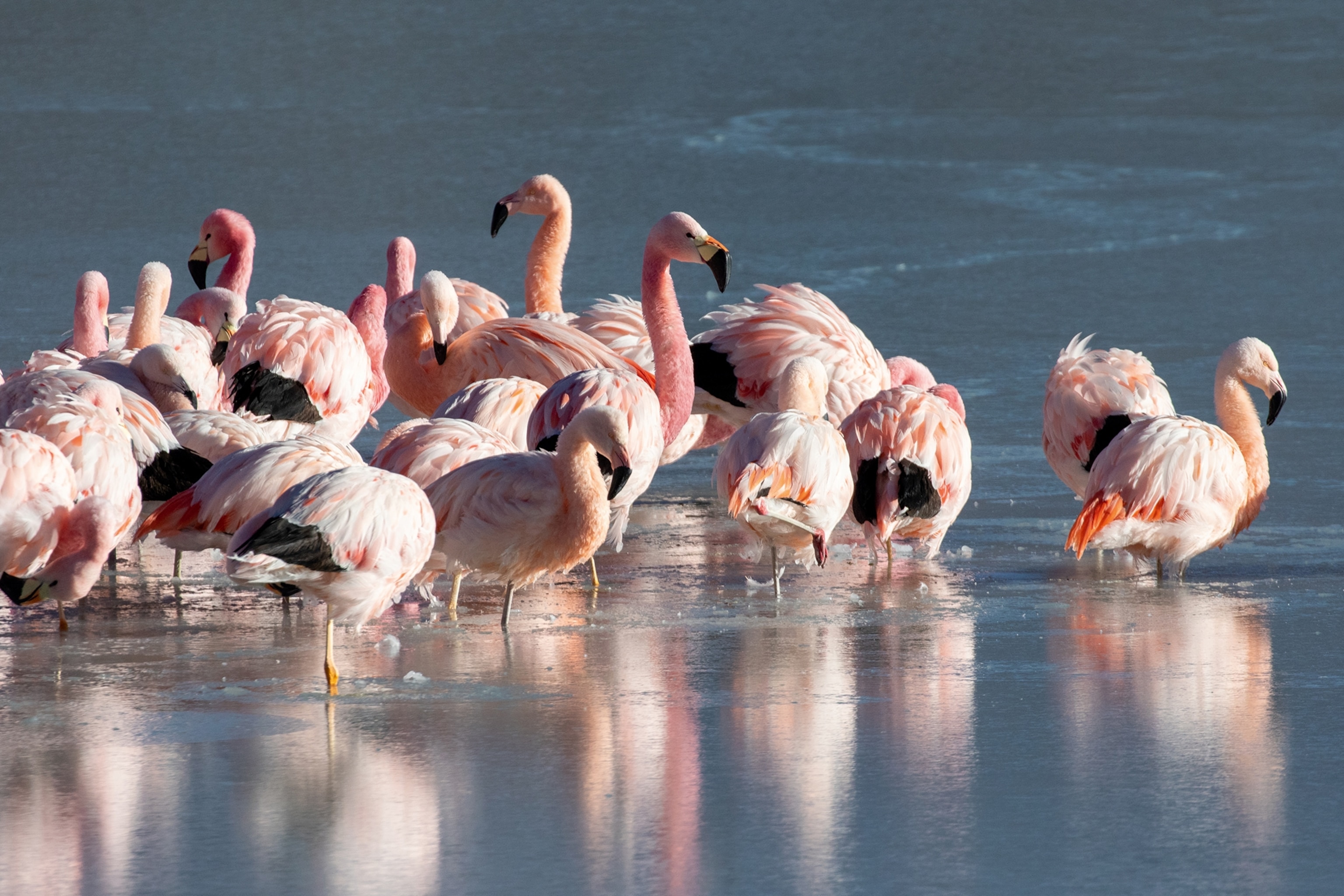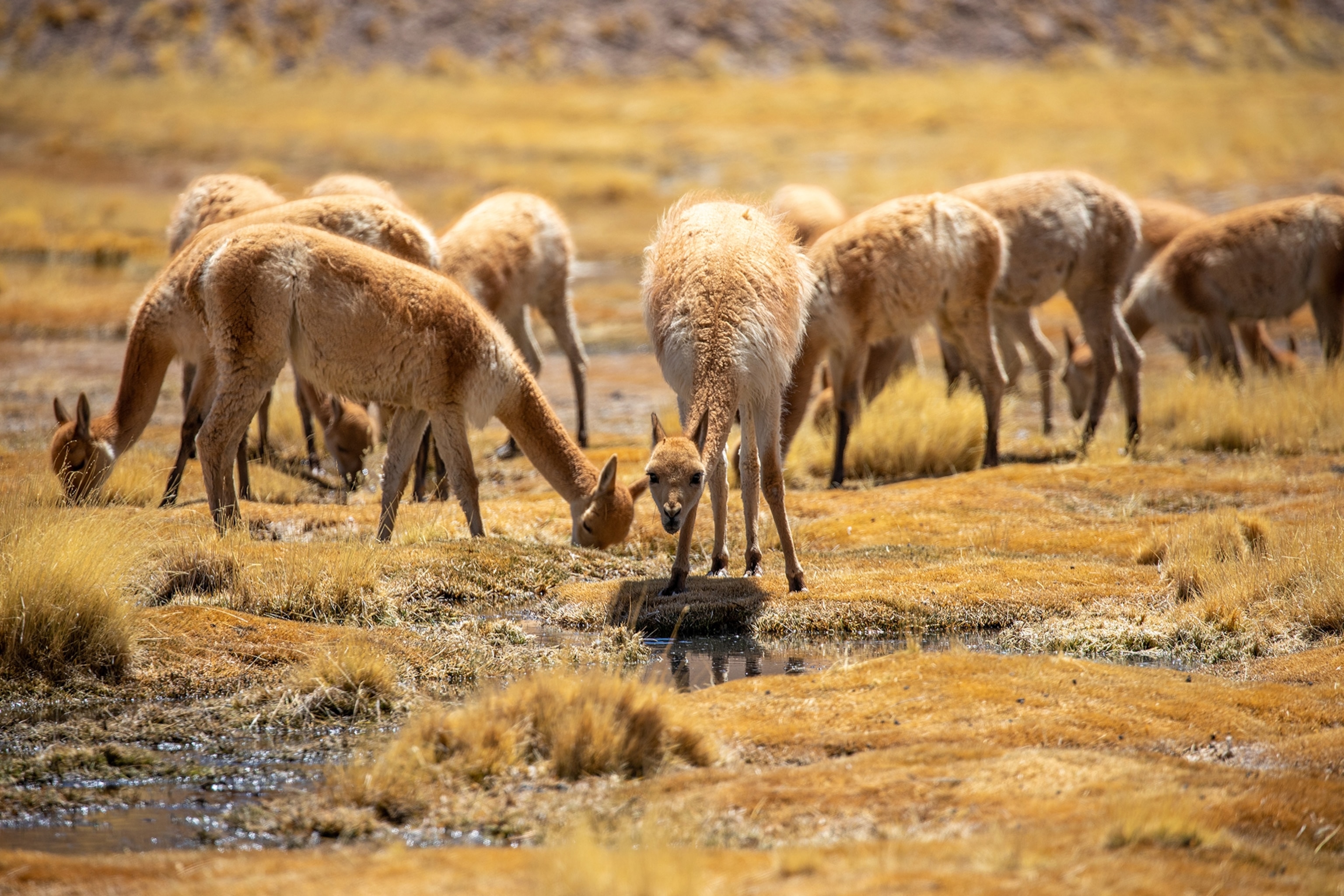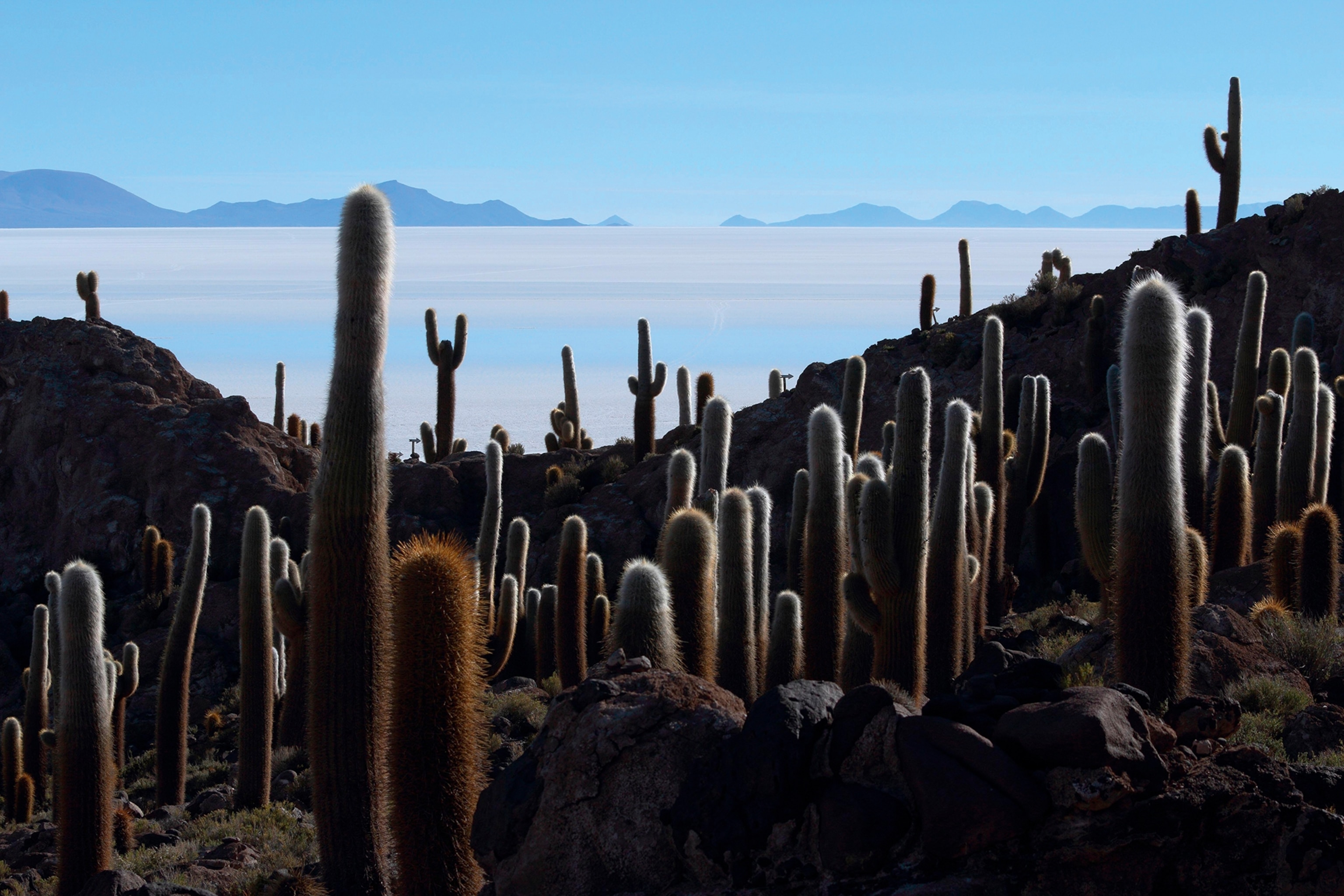
The ultimate Andes road trip, from Chile to Bolivia
The infamously inhospitable route from Chile's Atacama Desert to Bolivia's otherworldly Uyuni salt flats has been upgraded. New lodges and guiding alternatives are reimagining this well-trodden andean journey. At the nose-bleed altitudes of the Altiplano, Indigenous communities eke out a remote existence and rare wildlife stalks barren mountain plateaus.
We left the trees far behind as we climbed up to Bolivia’s Altiplano, but this was no place for them anyway. The dryness would be fatal, and even if they could find water, the ferocious winds wouldn’t allow them to stand. On this high-altitude plateau, life has had to make some extreme adaptations to survive, finding ways to eke out water and nutrition over 4,250 metres above sea level. Trees are yet to find a solution.
Up here, the landscape inspires a plethora of similes; the mountains look tie-dyed, psychedelic, rainbowed — like technicolour dream coats. When we pull over in our 4x4 — a swaying cross and rosary beads finally falling still beneath the rear-view mirror — my Chilean guide Micaela Díaz explains that the surreal valley we’ve found ourselves in is known as the Salvador Dalí Desert. “Because it looks pretty weird, no?”
This is one of the early stops on a new version of a classic journey that travel company Explora is calling La Travesía, meaning ‘the crossing’ in Spanish. It’s an adventure tour linking two of South America’s most bizarre landscapes: Chile’s Atacama, the driest nonpolar desert in the world, and the Salar de Uyuni in Bolivia, the world’s largest salt flat. It’s a remote road trip of around 325 miles, but the ‘roads’ are mere suggestions of routes that run through much of this high desert. We are travelling by 4x4 and the plan is to make stops at three new lodges Explora has built along the way to break up the journey. The roof is laden with spare fuel and tyres, reminders that we’re about as off-road as it’s possible to be.

The trip had started a few days earlier in the Chilean town of San Pedro de Atacama, the tourism capital of the desert, at the upmarket hotel Explora has long operated on the outskirts of town. Almost every night, the sun sets across a cloudless sky here, sending its dying rays against the satisfyingly conical peak of Licancabour volcano, which overlooks the town. Atacama is rarely plagued by cloud, and so the hot days in San Pedro are very often treated to this beautiful death. Licancabour can become so red it appears to have turned inside out. The first time I saw it was in the late summer of 2011, as a battle-hardened backpacker. Back then, just as now, I’d arrived in San Pedro to make the well-trodden crossing from Chile into Bolivia across the Altiplano. Explora’s version of the route is 100 times more expensive than the budget one I did back then, and at least that many times more comfortable, but the hard realities of this famously abrasive environment remain the same.

I’m making the journey with Micaela — or Mika as she prefers to be called — and Bolivian driver Silvio Huayca Ricaldi. In the build-up to the launch of the Explora route, Mika was part of the scouting team that worked out clever ways to avoid the backpacker tourist convoy that has long dominated the route and devised the activities to be offered at each lodge along the way.
We quickly bonded over tales of the backpacker journey we were about to retrace, after discovering we’d both made the crossing in the same year more than a decade ago. “Things felt precarious and there were no showers,” she said as we headed north towards the El Tatio geysers on a day’s exploration around our San Pedro base, the start point for Explora’s La Travesía. “Everything was rushed. I remember it felt like the soup saved my life when we got to the cold refugio one night.”
The Atacama’s El Tatio Geysers were an intimidating attraction to kick-start the trip with. At lower altitudes, I’d seen pampas grass swaying drunkenly as it huddled close to a rare Atacamanian river, but up here the land seemed instead to be burning. Terrific heat surged from underground, then hit the cold desert air to create permanent columns of steam. The gurgling ground had already put some mammalian part of my mind on alert, but just in case curiosity were to get the better of me, Mika told me a horrific story about an unlucky Belgian tourist who fell into one of these boiling pits and was rescued with 75% of her body covered in burns. I stood well back.
A couple of days later we had packed up our gear and made for the border, a dusty shambles with barking dogs, smoking guards and a bottleneck of tourists all with the same plan. At Laguna Blanca, the first stop on the Bolivian side, this resulted in a queue of touring cars. The majority gathered at the bleached lakeshore, and as everyone shuffled out into an unwelcoming wind, they spotted a lone Chilean flamingo in the water. The bird regarded them with its head upside down, perhaps thinking they looked as ridiculous as it did, but as the crowd grew louder and closer, it straightened up. When the first tourist tried to take a selfie, the flamingo took to running, then let that same stiff wind carry it aloft and away from the throng.

Part of me wondered if that scene would repeat itself at every step of the journey. The flamingos, although abundant, tend to gather in the same lakes, attracting a regular stream of tourists — would we just be following this convoy towards Uyuni? But Mika did an impressive job of making sure that after this initial scrabble to get away from the border, we rarely saw another vehicle. In the Salvador Dalí Desert, we watched the group of 4x4s pull away, its dust trails rising high into the sky.
Remote roaming
Each evening we devise plans for detours and activities for the following days, plotting the best spot for a picnic and trying to work out ways to adequately photograph the immensities of the soaring landscape. There are no significant towns along the way.
The lodges, meanwhile, fit into these grand scenes with minimal disruption. They’re stilted, so as not to cause too much damage to the land below, and employ local Indigenous workers. After seven hours of bumpy driving, the first one we reach looks like an industrial shipping container from afar. Yet it’s deceptively comfortable — even opulent — inside. The detours, meal stops, treks and fauna-related distractions combine to leave little time for anything other than eating and sleeping at the lodges. Yet by a great distance they’re superior to any alternatives along the route, each one offering superb views across the Altiplano.
A few hours after the Salvador Dalí Desert, we reach the enormous basin of Laguna Colorada, one of the most photogenic stops along the route. A complex mix of minerals have accumulated here, giving the lake a particularly alluring blend of colours, creating the impression of an artist’s palette. Hundreds of James’s flamingos feed in its shallow waters, adding dots of pink to the reds, whites and blues around them. By the shore, a wandering herd of vicuñas — cousins of the region’s llamas and alpacas — add splashes of orange and gold.
Since the 1960s when the Bolivian vicuña population dipped to four figures as a result of being hunted for its meat and fur, these extraordinarily hardy camelids have been protected. It’s been a remarkably successful conservation project, with numbers now estimated to be in the hundreds of thousands across Bolivia, Chile, Ecuador and Peru.

To see them shambling around the Altiplano, this seems almost miraculous — even without people on their case, nature seems out to get them, whether through the violently inclement weather or the murderous plans of elusive pumas. The water is often loaded with poisonous minerals, while the salty shrubs seem to offer little sustenance. “They look cute, but they’re pretty tough,” says Mika. “We’ll see plenty of these guys as we go.”
They aren’t the only creatures to have adapted to the harsh conditions. Two days later, the walk around Laguna Negra proves to be one of the best of the trip. This is partly because it’s a point-to-point hike, with Silvio waiting for us at the end with another windswept lunch, but mostly because of the scenery and wildlife. This classic wetland terrain requires a bit of hopping across spongy islands, but gives us a good look at giant coots, Orinoco geese and Puna teals. Ahead, a rocky outcrop looks like it could stand in for Pride Rock in The Lion King.
“I heard they saw an Andean mountain cat up here,” says Mika, never breaking her gaze from the promontory above. This stripy, thick-furred feline is one of the most endangered cats in the Americas; sightings are rare and populations in its native High Andes habitats are declining. “It’s a perfect location for them — lots of places to hide and plenty of viscachas [a rabbit-like rodent] for them to try and eat.” Has she ever seen one? Mika dips her head slightly, conceding that, no, she hasn’t been that lucky, and the trek continues.
A blank space
From above, it looks like a mist enveloping a valley, with occasional peaks daring to poke their heads into the blue sky. The reality is far more curious: an antique ocean, drained until a thick salt crust was left above a huge briny sea of lithium. The mountaintops are, in fact, islands, and the unending whiteness of the Salar de Uyuni — the final leg of Explora’s tour — won’t dissipate like a benign mist.
“What do you think?” asks Mika as she sets up a picnic at the soaring Pukara Chillima viewpoint, which hangs above this singular landscape on a mountainside. I don’t really have an answer for her. What to think about this near-mythic place? South America is a continent not short of globally famous landscapes. Christ the Redeemer atop Corcovado mountain in Rio de Janeiro, the Incan ruins at Machu Picchu, the impossible spires of Chile’s Torres Del Paine National Park… Those places are defined by what they have, by their geology and their iconography, but the world’s largest salt flat is instead a void, a place of deprivation.
Its surface is almost indescribably strange: crusty like old snow, but meaner, less forgiving. The grip the salt affords my hiking boots is extraordinary and sole-destroying. In places, the millennia-long process of evaporation has left hexagonal ridges on the surface, like neatly placed paving stones in the planet’s weirdest garden.
Sunsets here are an event. Shadows stretch impossibly long across the white ground, giving the impression that they belong to aliens 100ft tall. The last rays of the day catch the little ridges, exaggerating the polygons and calling to mind a kaleidoscope. Explora has set up its final lodge just outside the salt flat, on a peninsula with excellent views across this ivory land. From this point, the opposite shore of the dry lake is almost 80 miles away.

The activities available from the lodge mainly focus on simply being in the midst of the void, following roads that are defined only by black streaks — the tell-tale signs of rubber flayed from the tyres of touring cars. On the southern shore of the salt flat there are cultural offerings, too. One salt-baked morning, we visit the Grotto of the Galaxies, a cave network accidentally discovered by corn farmers whose crops had, unsurprisingly, struggled in the caustic soil. Doña Martha Lopez, the widow of one of the men who found them in 2003, is now the custodian of this particular underworld.
The first cave was full of chulpas — pre-Incan graves, sheltered from the wind but open-topped. “Most of them were empty, apart from the bones,” says Doña Martha. “We started looking around for necklaces or other things that people would have put as offerings, but instead we saw a peculiar shape on the cave wall.” They started digging and soon pushed through into a second cave. A bizarre labyrinth lay ahead of them: petrified algae and porous rock that looked like it had been tunnelled into by several worms — perhaps one giant one and its offspring. Standing there, I see it as they would have done two decades earlier, only now it’s lit in a way that makes it feel simultaneously palatial and haunted.
It’s almost a relief to step back out into the dazzling expanse of the salt flat half an hour later. Mika explains that for our final excursion we’ll hike up one of the 30 islands in the midst of the ancient sea. Isla del Pescado is popular with tourists on cheap package tours starting in Uyuni town, but we push past the groups to another, semi-secret, option, where we have nothing but huge cacti for company.
The climb is fairly short, but at an altitude of over 3,650 metres, it’s a breathless 45 minutes all the same. At the summit, we stop for drinks and a snack, Silvio’s Lexus a tiny dot in the vast whiteness below us. I stand to take a photograph, and for a second there’s no focus — I can’t tell if it’s the camera or me.
To subscribe to National Geographic Traveller (UK) magazine click here. Available in select countries only).
You May Also Like
Go Further
Animals
- 5 clever animals that treat and prevent their own illnesses5 clever animals that treat and prevent their own illnesses
- What would the world look like without mosquitoes?What would the world look like without mosquitoes?
- Social media loves to villainize dolphins. Here's why it's wrong.Social media loves to villainize dolphins. Here's why it's wrong.
- How did wolves evolve into dogs? New fossils provide cluesHow did wolves evolve into dogs? New fossils provide clues
- This unorthodox method is saving baby parrots from extinctionThis unorthodox method is saving baby parrots from extinction
Environment
- ‘Corn sweat’—and other weird weather phenomena—explained‘Corn sweat’—and other weird weather phenomena—explained
- A sea tornado sank a yacht. We might see them more often.A sea tornado sank a yacht. We might see them more often.
- How billions of dollars are revolutionizing ocean explorationHow billions of dollars are revolutionizing ocean exploration
History & Culture
- How did ancient Egyptian obelisks end up all over the world?How did ancient Egyptian obelisks end up all over the world?
- What we’ve learned—and lost—since the Titanic wreck was foundWhat we’ve learned—and lost—since the Titanic wreck was found
- Did Babe Ruth really ‘call’ this legendary home run?Did Babe Ruth really ‘call’ this legendary home run?
- The real history behind the legend of China's Monkey KingThe real history behind the legend of China's Monkey King
- How new technology transformed the American workforceHow new technology transformed the American workforce
Science
- Is mouth taping the secret to a better night's sleep?Is mouth taping the secret to a better night's sleep?
- Mold is in your kitchen—and in places that might surprise youMold is in your kitchen—and in places that might surprise you
- Why some say tennis is 'the world's healthiest sport'Why some say tennis is 'the world's healthiest sport'
Travel
- Discover America's Oktoberfest capital: CincinnatiDiscover America's Oktoberfest capital: Cincinnati
- Here's what an astronaut has to say about space tourismHere's what an astronaut has to say about space tourism
- 4 of the best food experiences on Scotland's Isle of Skye4 of the best food experiences on Scotland's Isle of Skye
- These are the must-see sights of Italy's Veneto regionThese are the must-see sights of Italy's Veneto region
- A guide to St John's, Atlantic Canada's iceberg capitalA guide to St John's, Atlantic Canada's iceberg capital






